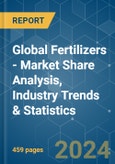The Global Fertilizers Market size is estimated at USD 384.37 billion in 2024, and is expected to reach USD 543.20 billion by 2030, growing at a CAGR of 5.93% during the forecast period (2024-2030).
Key Highlights
- Fastest growing segment by Product - Iron : The alkaline soils with high pH and degrading health and quality of soils are making them deficient in Iron thus increasing the demand globally for high-yield crop production.
- Largest Segment by Crop Type - Field Crops : Field crops are widely cultivated worldwide and are a staple food in many parts of the world. They account for a maximum share by area in most agricultural countries.
- Fastest growing by Speciality Type - SRF : SRFs are safe for the soil and environment as they precisely release nutrients into the soil throughout the cropping season and reduce the leaching of nutrients.
- Largest segment by Country - China : China is the most populous country in the world. It has a large cultivable land with a high fertilizer application rate per hectare in order to maximize crop yields.
Fertilizer Market Trends
Field Crops is the largest segment by Crop Type.
- In 2021, field crops dominated the global fertilizers market, accounting for about 82.1% of the market value of the global fertilizer market, at about USD 157.14 billion. Field crop production is dominant worldwide, and more than 95.0% of the agricultural land in the world is under field crop cultivation. Rice, wheat, and corn are the major field crops produced globally, and these three crops account for about 38.0% of the global agricultural land.
- Horticultural crops account for about 12.7% of the total fertilizer market value worldwide. Horticultural crop production is dominant in developing countries, particularly in the Asia-Pacific region. The Asia-Pacific region's dominance in the global horticultural fertilizer market is primarily due to the presence of about 73.0% of the global horticultural cultivation area, which is about 137.66 million hectares of land under horticulture cultivation.
- The turf and ornamentals segment is the smallest fertilizer market, followed by horticultural crops. In 2021, the turf and ornamentals segment accounted for about 4.9% of the market value of the global fertilizer market, at about USD 9.56 billion. The turf and ornamental fertilizer market is a fragmented market. However, developed regions like North America and Europe occupy a major market share compared to Asia-Pacific and South America.
- Asia-Pacific dominates in growing both field and horticultural crops worldwide. The Asia-Pacific fertilizer market is growing at a fast rate. The European region is the second-largest fertilizer market, followed by the Asia-Pacific region. The increasing urbanization in many regions and the decreasing overall agricultural area are increasing the demand for fertilizers and are expected to drive the fertilizer market during the forecast period.
Asia-Pacific is the largest segment by Region.
- The global fertilizer market grew at a stable rate during the study period, registering a value of USD 191.13 billion in 2021. The Asia-Pacific region occupied the largest share of 40.5% in 2021, followed by Europe and South America.
- China is the largest producer and exporter of fertilizers in the region and the world, and it contributes to 25% of the global fertilizer production, as per the USDA. India is the world's second-largest consumer of fertilizers, with a consumption volume of 70 million metric tons in 2021. Despite being the third-largest producer of fertilizers globally, India is still import-dependent. India is the fastest-growing country in terms of fertilizer usage, and this is anticipated to grow significantly in the future.
- France is one of the largest fertilizer-consuming countries in Europe, with an expected overall share of 20.1% by the end of 2022. The market value is expected to reach USD 9 billion by the end of 2022, with a 5.8% Y-o-Y growth rate. The adoption of advanced cultivation methods will also increase the usage of specialty fertilizers.
- In South America, the area harvested for major food crops has been continuously increasing. Field crops dominated the South American fertilizers market by accounting for 95% of the market share in 2021. The top three crops grown in South America are soybean, corn, and sugarcane, which have increased significantly over the past two decades.
- The United States is the largest market in the region, accounting for about 82.1% of the total fertilizer market value in 2021, as it occupied about 73.6% of the total agricultural land in North America.
- With the increasing cultivation of field crops, along with a subsequently increased demand for fertilizers, the market is anticipated to grow during the forecast period.
Fertilizer Industry Overview
The Global Fertilizers Market is fragmented, with the top five companies occupying 27.63%. The major players in this market are CF Industries, Israel Chemicals Ltd, Nutrien Limited, The Mosaic Company and Yara International (sorted alphabetically).Additional Benefits:
- The market estimate (ME) sheet in Excel format
- 3 months of analyst support
Table of Contents
1 EXECUTIVE SUMMARY & KEY FINDINGS2 REPORT OFFERS7 KEY STRATEGIC QUESTIONS FOR FERTILIZER CEOS
3 INTRODUCTION
4 KEY INDUSTRY TRENDS
5 MARKET SEGMENTATION
6 COMPETITIVE LANDSCAPE
8 APPENDIX
Companies Mentioned (Partial List)
A selection of companies mentioned in this report includes, but is not limited to:
- CF Industries
- Compo Expert
- Coromandel International Ltd.
- Haifa Group
- IFFCO
- Israel Chemicals Ltd
- Nutrien Limited
- Sociedad Química y Minera (SQM)
- The Mosaic Company
- Yara International
Methodology

LOADING...










